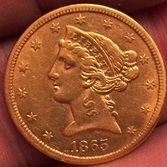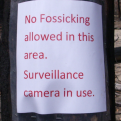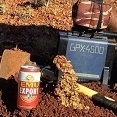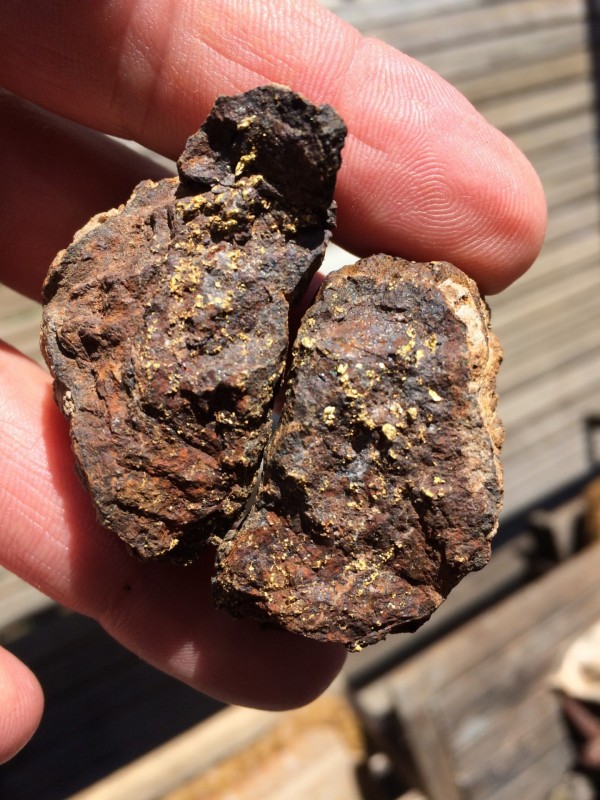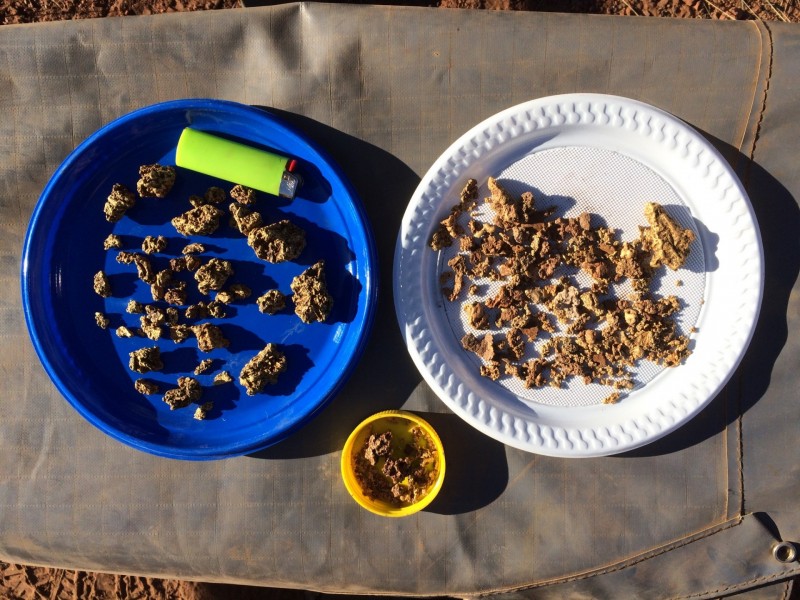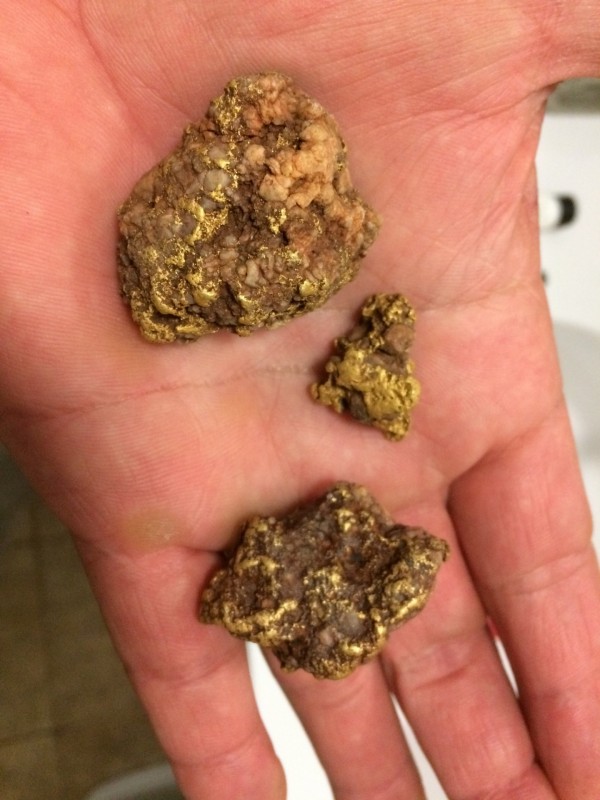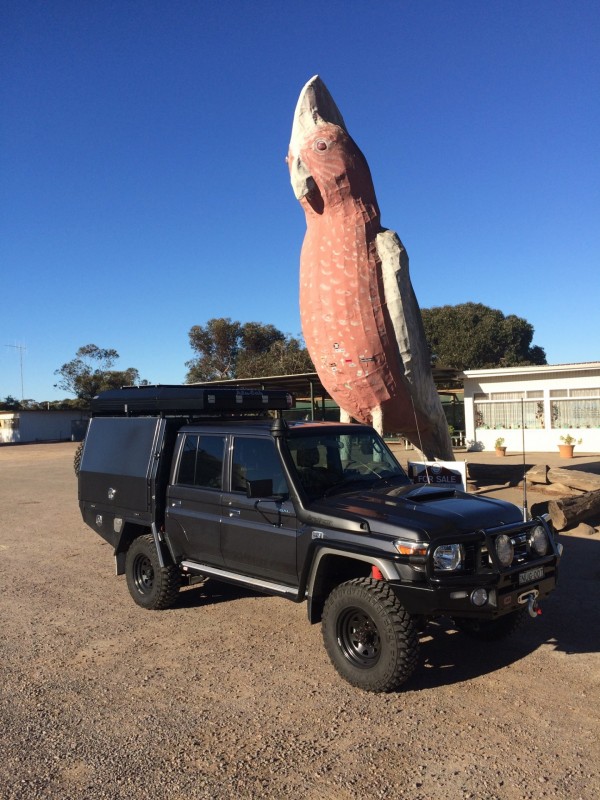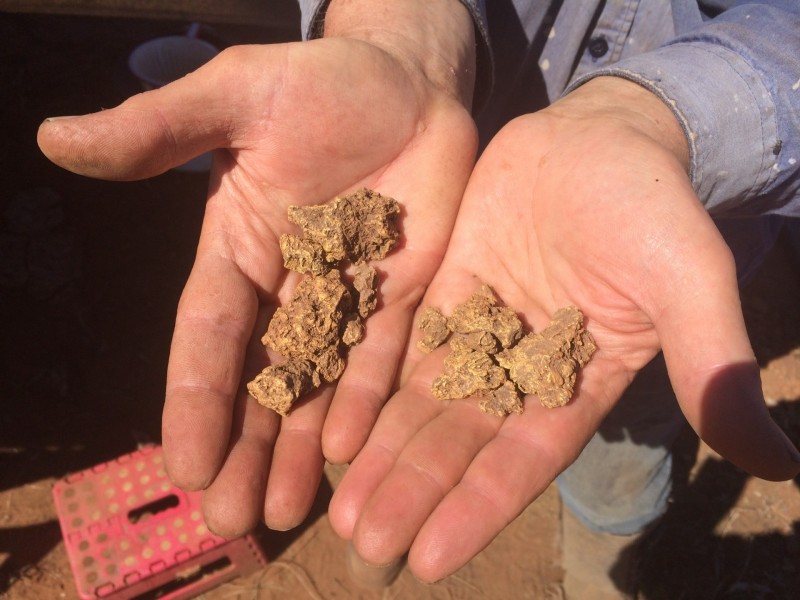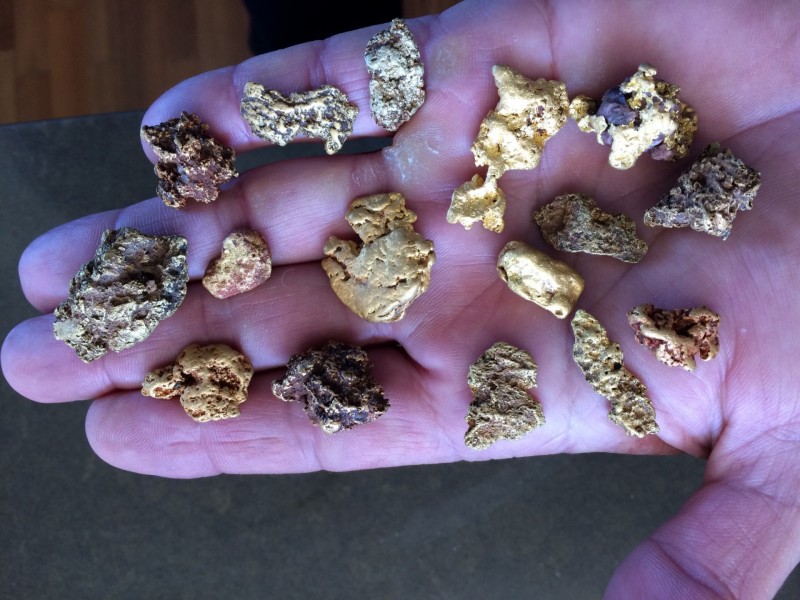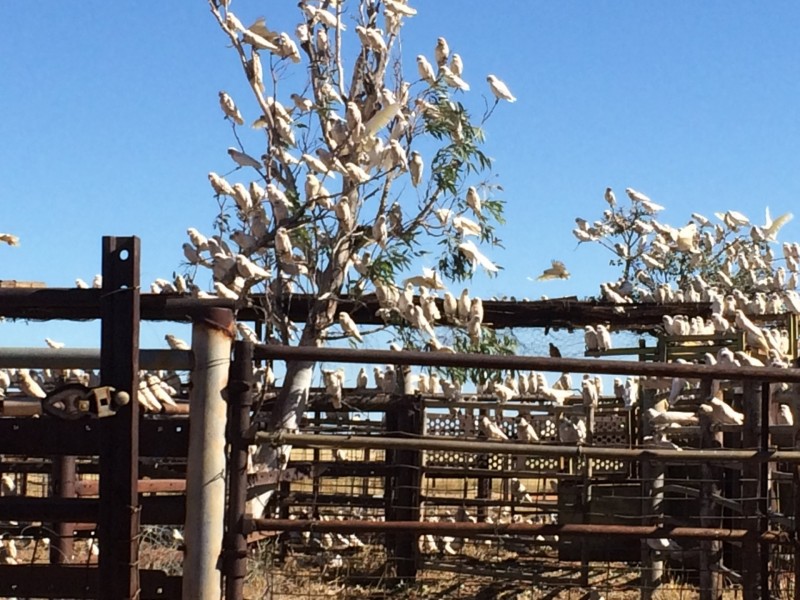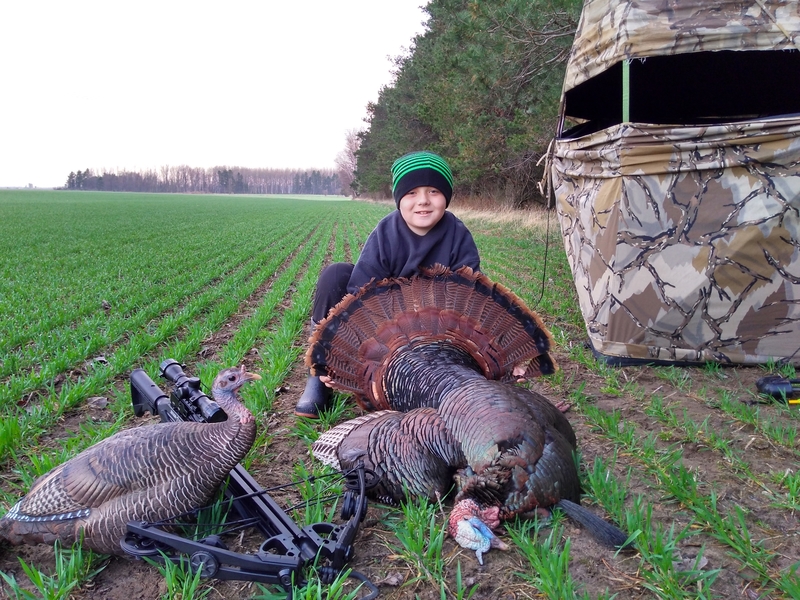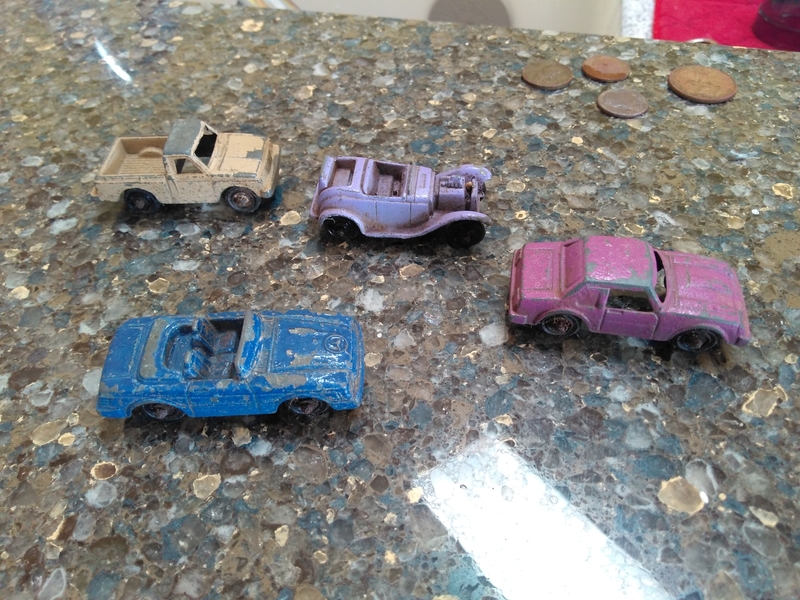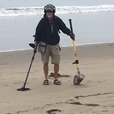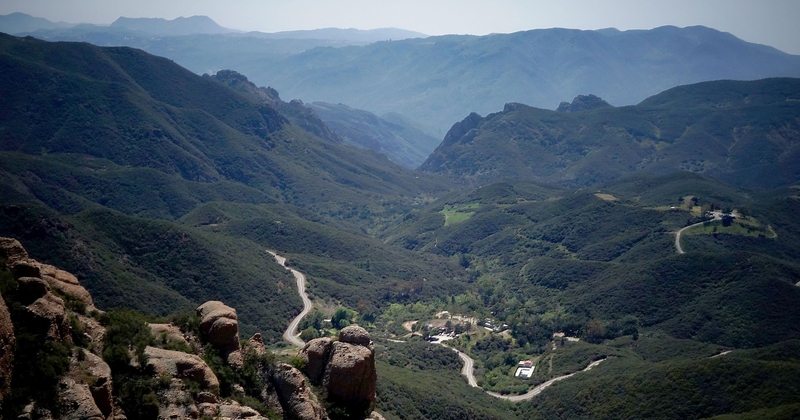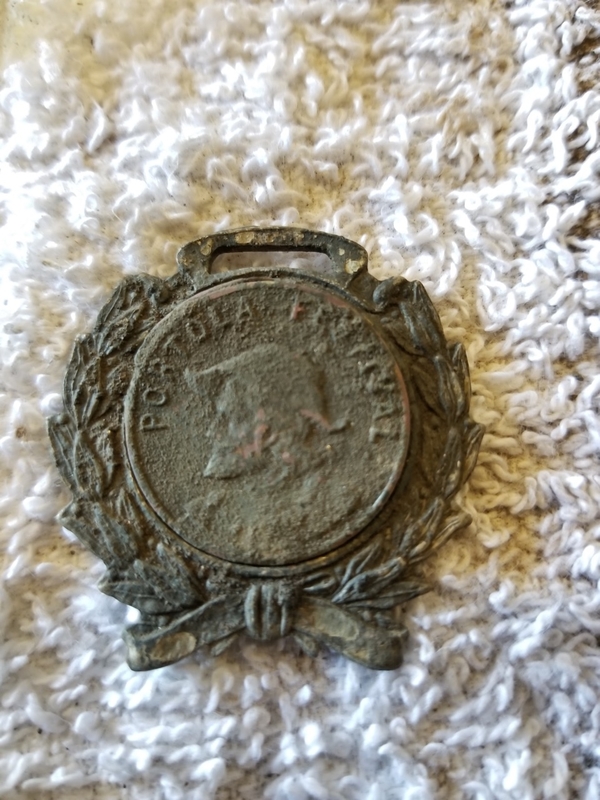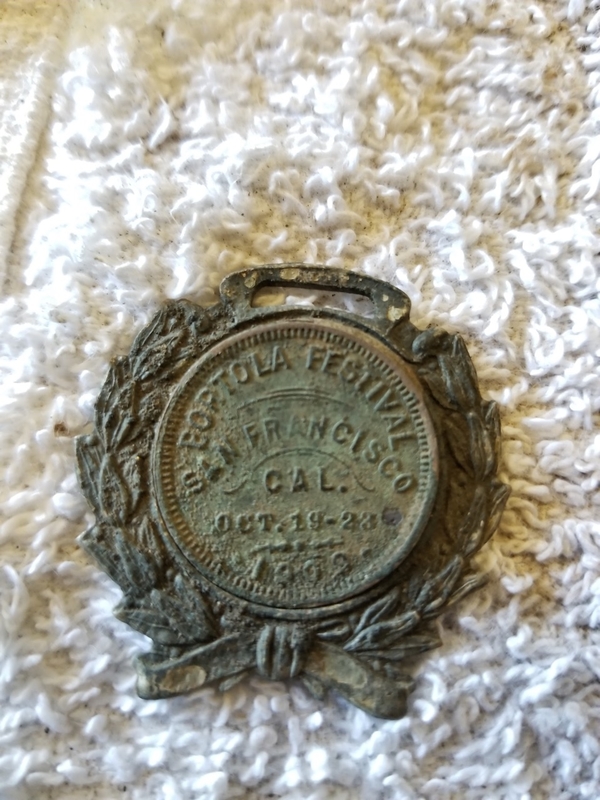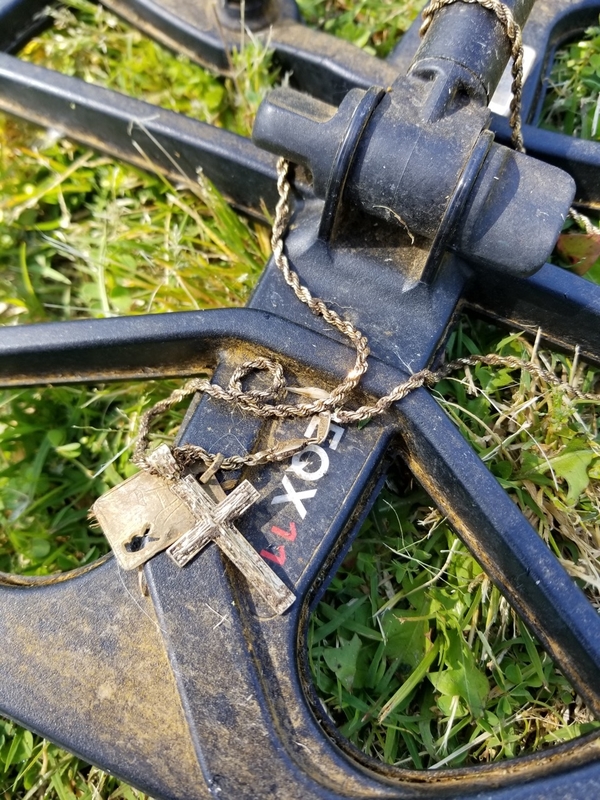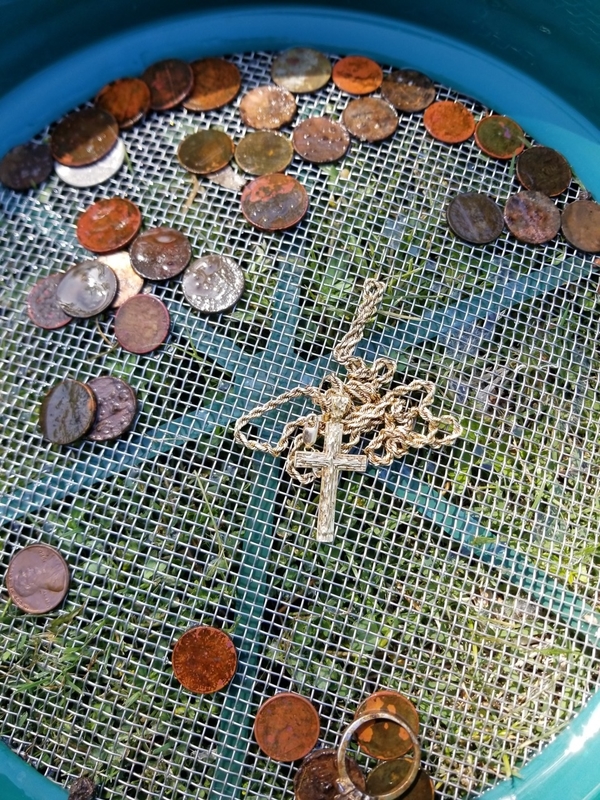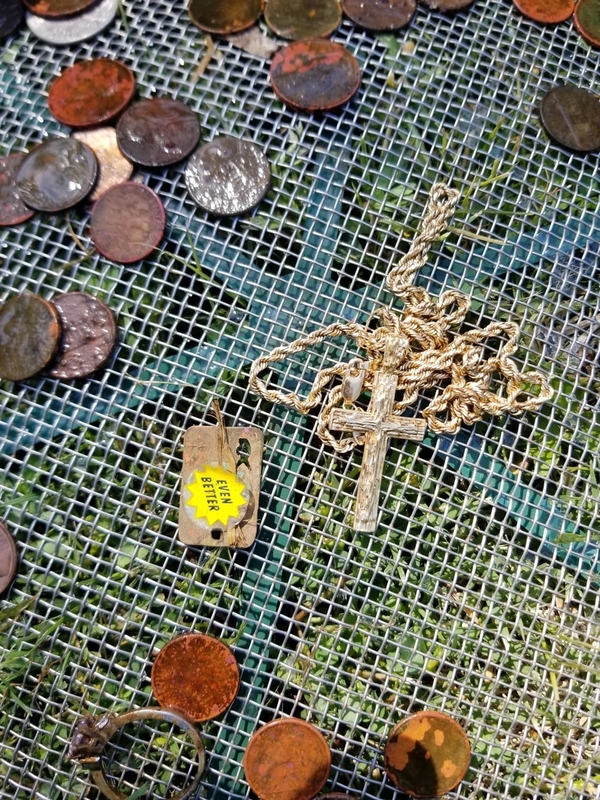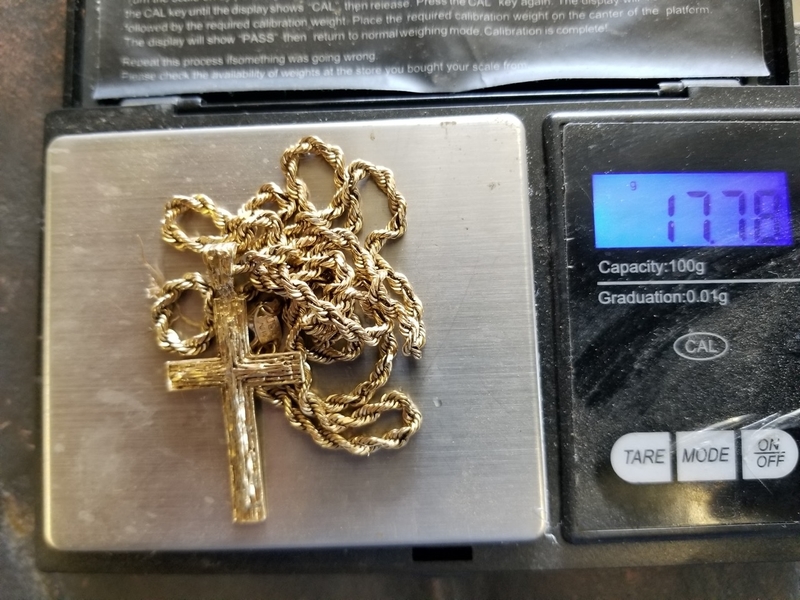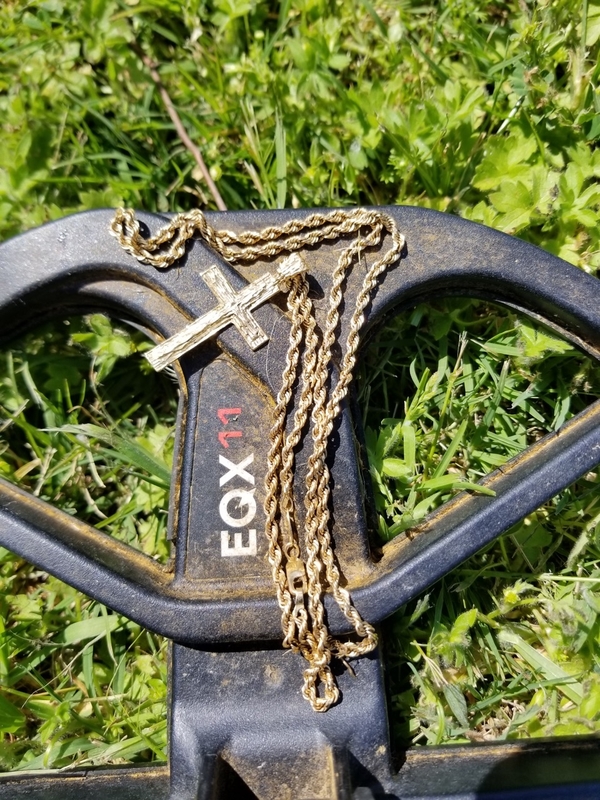Search the Community
Showing results for tags 'stories trips adventures'.
-
I had some afternoon time today and decided to see what the wind blew in to the southern California beaches. The tides are bad, the waves are small and it took me over a mile before I had my first target penny! These are the same beaches where I've found lots of targets in the past but these small wind waves are only moving sand. It is all deposit mode, sanded in as you might say. On the way back I decided to do a bit of blanket line near a surf break. I found a little spill for about $1 in change when a surfer came up to me and asked if I had found his Toyota key. I had only been there about 5 minutes and I told him I had not but I'd help him look if he knew EXACTLY where he had sat and picked up his roll on the way to his car. He showed me and I began circling that area and he dragged his foot along the path he took to the parking lot. I followed that line with my Nox 800 and the 15" coil and found a couple more coins but not his key. I did a double width pass on his path and then told him I had no results after about 25 minutes. He was bummed and wanted me to take his number in case I found it but I said I was leaving and there was no chance I was going to find it tonight. He said thanks for helping and we parted. On my way back to my parking spot I saw the lifeguard truck ahead of me watching the sunset. I went up to the guy and he cracked his window and wanted to know what this metal detectorist wanted. I told him a surfer was looking for his key and I had been helping him and he reached down into his lap and says, "I have it, where is the surfer?" I pointed him out about 1/3 of a mile down the beach and he took off. I watched as the surfer went over to the truck and took the key from the lifeguard. It would have been nice if the surfer could have spotted me and waved or even the lifeguard could have come back and said something but that did not happen. I didn't find the surfer's key but I did find a story with a happy ending. Mitchel
-
Cabin fever setting in, was needing to get out. It warmed up to 38 degrees and that's just warm enough to melt a little snow off beach and the warm air blowing through gravels allowed me to dig targets. Nothing special 5 coins and trash, but I've been hitting this beach since I got the NOX last March, cleaning out trash, thinking there should be a ring sometime, just Not Today. I know there has to be one some time. ( Right ??? ) I have to think not everyone thought to take jewelry off before a summer swim. Sure felt good to get out. Kenai Lake / Quarts Creek Camp Ground Beach. Watch out Nevada / Arizona / Florida Treasure Coast next winter, I'm a coming !!!!! Haha !!!!!!
-
My prospecting buddy in San Diego and I decided to take a run down to Baja to see if this summer's hurricane event had moved any gold around. This particular Baja placer has been pretty popular over the past 20 years and we've pretty much hunted out all the easy stuff so we had high hopes for a new bonanza. We left on Monday crossing the border at Calexico. I was waved through after a cursory examination by the Mexican border officials. My friend was in a different lane and he was subjected to a much more thorough examination. I think it was end of shift and the border officials needed to make some quick money. Four of them pulling everything out of his truck. They ultimately came to his 7000 detector. He explained its use and then they asked what it was worth. He lied and told them $4000.00. They saw dollar signs because according to them he would need to pay an import duty on the equipment, $420.00 US dollars cash. I guess 100 bucks apiece is a good nights work. He refused and told them that he would just return to the US. After that the price came down to $240.00. He still refused and we used the turnaround lane back to the US side of the border. It's hard to argue their notion of justice. We spent the night at my house in sunny Yuma and decided to cross at Algodones the next morning. That crossing was going well as far as inspection, but then the immigration officer inquired as to our Mexican Visas. We've never needed a Visa in Baja unless crossing the states of Baja Norte to Baja Sur. So, we bought some much needed $35.00 cash only Visas and continued on our way. The summer hurricane wiped out most of the paved highway just outside of San Felipe. They were working on replacing the highway but in the meantime you're restricted to a rough one lane dirt road over about 40 miles. From my house to the Placer is abut 240 miles and we arrived in the early afternoon. The prime ground is another 3 miles by ATV. We spent the rest of the afternoon building some ramps and filling big holes to run the my Rokon and his Yamaha Big Wheel up the canyon. The hurricane had run water about 20 ft high through the canyon so all our improvements from last year were washed away. It was tough sledding all the way but I didn't get unhorsed this year. My friend took a nasty fall after his bike slid down a too smooth rock wall. He was hobbled and we ended up cutting our trip short. Nevertheless, I got one good day of detecting in. I found a stretch of bedrock that last year had a foot of overburden on it. It was now swept clean and I found these small nuggets in bedrock cracks. I intended to check some promising ground about a 2 mile hike away, but I just couldn't justify leaving gold to find gold. Maybe next trip. The weather was great and the gold available, just not enough time after our border mishap and my friend's banged up knee.
-
My first pulse unit was a ML 3000, I had carried the unit to Az from Ak without opening the box. I was camped at Decision corners not to far from the old cemetery. Remembering events sometimes taxes you lol, but this was the year that Jonathan Porter came to the US and he was camped not too far away with his group. That evening I charged the big battery and laid everything out for assembly in the morning...After some food and detector assembly my friend and I drove over past the GPAA campground looking for a spot to try out our units. We parked near a metal building and I walked up the hillside towards a flat bench area I had spotted from the road...I made exactly two swings with my detector and I heard this signal sound I will never forget.. Weeee. Oooop lol that's gold for sure, and how could I be so lucky..
-
It's been well over 4 months since I have picked up a metal detector. A house remodel and some landscaping has kept me away from the treasure fields unfortunately. When my buddy Merton called and said he wanted to go on a hunt all I could think of was that I needed to get the house finished before I went goofing around with a metal detector. Reluctantly I told myself that I probably could use a break and so I invited him to come on down. Merton, being the thoughtful guy he is called a couple days before our designated date and gave me the option of cancelling but I told him to come down and lets go for a hunt! I was starting to look forward to it as we always have fun treasure hunting together. I had already decided we were going to the spot where I found the old antique gold ring this past May. I had yet to revisit this spot. https://www.detectorprospector.com/forums/topic/6528-needle-in-a-haystack/ This area is on private property and has a small area of mining activity. It's not on any map. It's a tough area for the nugget hunter, the dozen or so pieces of gold that I have found here are small and few and far between. To make matters worse the area is loaded with lead from #9 bird shot to old 50 Cal plus round balls. For now I've pretty much written it off for gold hunting and would rather be a lazy relic hunter there instead. Up till now I had never found a old silver US coin there despite having made 7-8 visits to the area. A few old Chinese coins, a couple powder flasks, some gun parts and the surprise gold ring form the last hunt were enough to lure me back. As the saying goes "if you don't use it you loose it" And I had forgotten how to operate the equinox 800. The night before our hunt I broke out the owners manual that I had printed out (my wife made a nice binder for me) and brushed up on how to work the machine. I went outside and played around in the yard a bit with the detector. I'd even forgot how to noise cancel and was beginning to have doubts thinking I was wasting my time. Saturday found us in the foot hills on a bright sunny morning surrounded by herd of 75 very hungry cattle. I told Merton I was going to go on a walk about starting where I had found the gold ring and I'd catch up with him later. Merton with his XP Deus headed for whats left of some old chimneys down in a flat close to some tailing piles. I decided to keep things simple with the equinox so I put it in park 1, 5 tones, ground tracking, recovery speed 5 and Fe 1. The ground here is very noisy and it took me a while before I got back into the hang of things knowing which targets to dig and which to ignore. After about an hour of detecting I had it down and was building confidence. About two or three hours had gone by when I caught up with Merton. Neither of us had found anything really good. The place is not a very target rich environment for the relic hunter. We went back to the truck for a beer and some lunch. After lunch I told Merton that I was going to go up on the hill above the main camp and workings since neither of us had hunted it very hard before. This is where things start to get interesting. I had been gridding the hillside for about an hour or two when I came across a rare high tone. Kinda scratchy...but repeatable. A couple swings of the pick and out pops a seated silver dime in excellent condition. Immediately I call for Merton who is about a hundred yards below me and show him the coin still in the hole. I tell him to start working this area with me. Merton is a very polite detectorist and using good etiquette he heads up hill a little ways from me as to not encroach upon my new spot. Maybe another 20 minutes or so goes by and I'm about 20 yards or less from where I found the seated dime and I get a mid tone on the Equinox..14-15 and repeatable. Thinking it's just another shot gun cap or lead ball I dig a little dirt out with the pick....my Garret carrot says the target is an inch or two behind and to the right of where I originally thought it was. Using the Lesche I start digging out the area and out pops this little gold shiny thing. I could only see part of it but it had a serrated edge and I immediately knew what it was even though I had never dug one before! Gasping and jumping backwards all I could do was call out for Merton to get over here! he could tell by my excitement that It was something good....he's smiling as he walks down..... "What did you get a half dollar?" I shake my head no...."Silver dollar?" again I shake my head no....."A GOLD COIN?" all I was capable of was looking up and smiling as I was still speechless. As I went down to reach for it and Merton says "CAREFUL DON'T RUB IT!" There was a lot of congratulatory back slapping, high fives etc... then without touching the coin I said I got to go to the truck and get my phone so I can take some pictures. The coin is in excellent condition (1853 2.5 dollar) which is hard to believe since it's been in the ground for well over a hundred years. Here are the pictures so you can see what we seen. We went back the day after and then hit another spot a couple days after that. We managed another Seated and a few other trinkets. I'm back to working on my house again and Merton is out at sea. But I'm looking forward to our next hunt together. What a great hobby. strick
-
The old coinshooter has been gone now for many years (1993) but I remember him very well..he used a CM 3 then, which he just wore out, it was replaced with a brand new Coinmaster 4...I got to hunt with him a few times and it was a pleasure to watch him slowly shuffle along he would stop scan back and forth and either dig or move on, I knew he was listening carefully.. We were hunting together in an old park, lots of targets old steel BCS mostly and other junk.. He called over to me and said what do you think about that? He used one of those old diggers that looked like it was made from conduit with a long narrow point, perfectly stuck on the end was a nice little gold ring..... This person had a ring collection that would choke you, in fact one ring he told me about that he had found was a gents gold piece with a large precious stone, he had taken it to a jeweler that cleaned it for him and I think later he sold it to the jeweler for enough to buy himself a new Ranchero...I tried to hunt with him as much as I could but we lived quite a distance apart and I was just starting to work on preliminary Trans Alaska pipe projects... By the time I could spend time with him he could no longer swing that heavy Whites unit but he liked tagging along with me.. The gold rings he had found were sold but the other pieces he had tied together on a string and there were many.. I haven't looked in the big canvas bank bag he gave me years ago that was almost full of dimes, quarters, halves and a few silver dollars he had found at the old Fairgrounds, parks and old closed country school yards.I .learned a lot by watching how carefully this person hunted, slowly, listening and moving around..He did his homework, a little research and talking to the old timers that stopped by watching him...Who was this person? This Old Coinshooter, I knew him very well, He was my Dad....
-
Last year was not a banner prospecting year for me. I got out a number of times and did detect some gold and did some dry washing, but it was a year of other problems and obligations. I had two trips to the hospital, one emergency by ambulance, and one for surgery on my heart (not open heart, but the doctor put a probe up through a vein into the inside of my heart). My wife had two stays at the hospital as well. We also spent time moving my elderly mother in law from southern California where she has few remaining relatives, up to Reno. I did get out and find some nice gold in my prospecting, but I made fewer trips and got less gold than I have in many years. I did however, do some serious hard rock prospecting in 2018 and made two deals with mining exploration companies to lease out properties that I own. One deal was made on a set of claims that I had staked years ago, while the other was on a large set of claims I staked in 2018 (along with two partners which I have in that claim group). We staked over 200 claims in that group and it took some time in getting all of those claims out and posted. The company that leased those claims from us flew a helicopter survey over them and made several exciting finds. The ore bodies likely found there are electrically conductive, and the coil and electronics used to “see” the ore bodies are of a pulse type design – just like the pulse detectors we use, but with a gigantic coil and a bit different electronics. So I can look at 2018 in a couple of different ways – for the direct gold I dug, it was a very poor year. Yet for the total money I made on my prospecting it was a different story. Counting the money I made on leasing out claims in 2018, if you calculated out the equivalent ounces of gold, that would make it my best year ever, by far. The money was the bullion weight equivalent of several pounds. So in 2019 I hope to stay out of the hospital, and to take no rides in ambulances. I pray my wife stays out of the hospital too. I hope to spend more time in the hills prospecting, and do more detecting and more drywashing as well. I will stake some more claims and see if I can get those leased out as well, but I really want to do my own prospecting as I enjoy that so much. For those interested in more details on the story of the claims I staked and how I got them leased off to two different exploration companies, I have a story this month in the ICMJ – called Making a Big Discovery. In the February and March issues I will have a two part article on how these lease contracts are structured and what a small miner might expect in such a deal. Photos – A few of my detected nuggets; the helicopter surveying my claims, and some of the ground where the claims are located.
-
Ok NursePaul touched down in OZ, picked him up on Saturday, but in his excitement to get over here he forgot his ports with clothes, Z, etc etc. no no regardless of what he says about Airlines, that`s my story and I`m going to stick to it. We are having a lot of trouble communicating, I don`t know what version of English you Yanks use but tis French to me for sure............ So here we are waiting for his gear coming via Pony Express-Cobb & Co and I`ve got the best excuse I`ve every had as to why I`m not finding gold.....................But the xxxx is good yes/no..............and we are sort working out sign language, although judging by the smoke coming out his ears I think we will switch to smoke signals...............
-
I was just updating links and realized I have been posting adventures to Steve’s Mining Journal for over twenty years now. The Journal started when the internet was new, and information about metal detecting and prospecting for gold was new and rare. Metal detecting was still an obscure activity and gold prospecting even more so. I started posting the stories on my old company website as a way to show people this stuff really works and to help promote the business. It was one of my better decisions, as documenting these adventures has turned out to be far more important to me than anyone else. Memories fade with age, and I can’t do this stuff forever, so it is great now to have all these adventures to look back on. Anyway, many people never leave the forums and explore the rest of this website, so I thought I would post this to celebrate the unofficial 20th anniversary of Steve’s Journal for those who have never wandered across it.
-
Well, it's with a certain wistfulness that I am about to spend my last night in Indian Harbour Beach, FL. This little island has been the closest thing to a "home" that I've had for the past 5 years. We towed our "big house" to Georgia a few days ago and got it all tucked in and safe from the Florida hurricanes. The "little house", our 27 ft toy hauler, is parked in our spot and all ready to go exploring for the season. There was a minor glitch with the Polaris as it wouldn't start when we took it in for new tires Thursday. Route 1 Motorsports says it's just the battery and I'm sure they will get it all straightened out for us before we leave Florida in a couple of weeks. I hunted "my" beach for probably the last time yesterday and had an awesome time with some old friends and some new ones. None of us found much except clad and lead sinkers, but Terry Shannon did say he found a 10K ring the day before....which Mrs. Shannon promptly confiscated. We'll be in New Smyrna Beach next winter, if we can get a spot reserved, so it will be fun learning to "read" a whole new set of beautiful Florida beaches. I've heard that they're not as sand-truck happy up there as they are here, so that will be a big plus. I do wish I'd had more time on my new Equinox before we left here, but at least I'll get in a couple more weeks of beach hunting at St. Lucie and Daytona before we leave Florida. Tomorrow I face the "downside" of this RV lifestyle, saying goodbye to some dear friends and knowing it will probably be the last time I'll ever see most of them. Those of you who also live this nomad life know how it is. You always say "we'll meet somewhere halfway in between for lunch next winter" and then you never do. At least with Facebook you can still stay in touch. So we're off to St Lucie in the morning, so ya'll please say a little prayer for safe travels, if you're so inclined. It is always greatly appreciated. On to the next big adventure! Ammie
-
I had seen a movie called "The Ballad of Buster Scruggs" pop up on Netflix and then saw Reg W comment on PA that he had seen it and mentioned there was some 'loaming' in it. Sat down to watch it tonight and it is a series of short stories. 4 stories in so far and they are all 'old west' themed. Some funny, some weird, some sad. Well, the last one we watched was called "All Gold Canyon" and about 5 minutes in I thought to myself "I know this story". I read it here on a thread that JW started - there is a link to the story in his first post. It is well worth a read and the short film does the story good justice too. Enjoy the read and if you get the chance enjoy the film - there is some very nice fake gold in it ?
-
Tom(CA) and I have been working a site that we researched that's produced several 1850's - 1860's seated coins, and some rogue early 1900's coins, as well as a variety of period relics. We tried to get one more trip in before Old Man Winter completely shut us down, and it did in fact shut us down, but not before I finally, got something I've been looking for for a long time, and after watching others find them over the years (I saw Tom dig three!!!), I was starting to think it would never happen. Well it finally happened, and it turned out to be a good one, an 1865 San Francisco minted Liberty Half Eagle!! Here she is out of the hole: Here she is rinsed off: Here's a video of the hunt: Less than 100 known, Mintage: 27,612 Although the mintage of the 1865-S is quite a bit higher than the mintages of the S Mint Half Eagles from 1858 to 1864, it compares in overall rarity to the 1858-S, 1860-S and 1863-S and is only slightly less rare than the others. Almost all known examples of this date are well worn with VF and lower being all one can expect to find. The 1865-S ranks second in the entire $5 series according to average grade and I do not know of a specimen that would grade better than EF. The very few specimens that I have seen were rather softly struck and the mintmark was always quite weak. Thanks for looking, hopefully the next one comes easier
- 30 replies
-
- 19
-

-
- gold found
- stories trips adventures
-
(and 3 more)
Tagged with:
-
Going to Quartzite area for two weeks starting next Friday the 19th with two friends. Be the first time spending that much time round there. Temperatures are getting cool enough, hope to find some gold.
-
A comment I made on Jins post recently reminded me of how easy it is to walk over good sized gold. We are all familiar with the horrible loud screams detectors make over big surface targets. Sometimes the cause is obvious, usually surface rubbish such as a visible piece of tin or squashed beer can. Occasionally, when walking paddocks (which I mostly do) it turns out to be something useful, such as a lost spanner or fuel cap from a tractor - I have even found a grease gun lying concealed in the grass. These items I always return to the grateful landowner. More commonly, however, it is something useless like an old horseshoe, worn out cultivator point and/or the sheared bolts which once held it to the plough tyne. After digging a number of these the temptation to keep walking (with ears still ringing) becomes ~almost~ irresistible. Back in the Minelab SD2200 days I had permission to work a large Victorian property located on the Tarnagulla granite pluton to the north of Dunolly. This had a number of unworked shallow Tertiary palaeochannels crossing it, on one of which I located a 7 oz patch. Mostly the gold was smallish and reasonably deep, but the same location was also littered with shallow shotgun shells. These were very loud and nearly drove me nuts, and in my frustration I ignored one outlier - - - Fast forward a number of years and, armed with later technology (GPX4000) I decided to check the patch once more and - - - WHUMP/SCREAM - - - greeted my ears over that same target. I kicked the dirt in annoyance - and then spotted the 70 grammer I had ignored years earlier: I had foolishly made the assumption that all the gold in that patch was deep and small, therefore loud shallow targets had to be junk - overlooking the possibility that something once deep could have been ploughed to the surface - - - I kept it to remind me of the old detecting maxim: "Dig your targets"
-
Two of us made the 5 day trip from eastern OZ to the Western Australian goldfields for a 8 week detecting trip.(armed with 7000,s and SDC) We targeted remoter spots that are not really on the radar. We invested in a pile of permits and researched lots of available ground spots. Lots of walking and lots of barren gullies and creeks...... but occasionally we found the odd gully or slope not touched by a detector that yielded some nice runs of gold. We went 50/50 with our finds, sharing is the way to get a bigger tally when 2 or 3 of you (of equal ability) spread out searching large areas. All up we shared 45 ounces between two of us. There are many ugly specimens not pictured and we will have a big crush and smelt day soon. Cheers RDD
-
The River I spent several weeks in early July, panning and sluicing on the N. Fork of the American River. I've been going to the same 10 mile section of the river for over 20 yrs. That part of the river is designated Wild & Scenic, so no motorized equipment and no claims. It's one of the few places in CA gold country you can access a free flowing river without stepping on someone's gold claim. Access is not easy, although there a a number of trails up and down the river. They're all rugged, often steep and always overgrown with poison oak. I have often encountered "locals" who at various times attempt to eke out an existence by panning and sluicing the river. Generally friendly and sometimes willing to share local knowledge of the gold. When I meet them I make a point to brew up a big pot of spaghetti and feed all comers. Many years ago, I met a guy my age driving a new Jeep Cherokee. He was socially awkward, but I learned he was a software engineer from the Silicon Valley and had taken up gold prospecting on weekends. He was not very successful, so my 6 yr old son and I invited him to come dig in a hole we had started. He sluiced a few buckets and declared that was more gold than he had ever found. Skip ahead 10 years, I found him living in a tent on the banks of the river having spent 2 years pursuing the golden dream. He was eking out an existence and seemed to be perfectly happy. Imagine a 6 mile hike uphill, just to reach a paved road, hope for a ride to town to get supplies then repeat the process back down. Supplies are limited to what you can afford and carry on your back. The local mining supply store pays 80 percent of spot, for good clean gold. This guy still had the math and engineering brain so he could tell me exactly how much he was earning per hr, although he did not factor that it was in fact a 24 hr a day job, living on the river. Every now and then "flatlanders" discover the place and bring down a bunch of gear intending to strike it rich. They are soon disillusioned and I find their gear stashed in the woods. I've seen one sleeping bag stashed in the same spot for over 4 years, untouched. Buckets and digging tools get carried away by spring floods and I find them littered on gravel bars. Access There is an old mining road ,overgrown, heavily rutted, washed out and frequently blocked by blown down timber. It currently takes me about an hr to travel just over 3 miles down that road crawling in 4 wheel drive low locked in 1st gear. At one time you could drive to within 100 yds of the river. There was a fabulous camping spot under a massive oak, with a spring nearby. In their infinite wisdom, the BLM blocked the road about 1.5 miles from the old camping spot. They brought in some heavy equipment and dug tank traps to block all future traffic down the road. For many seasons I hiked the rest of the way down on a variety of trails. A few yrs ago, my son, then strapping teenager and I started hacking an ATV trail around the tank traps. We spent a few hrs a day for over a week cutting a new trail. It's passable by ATV to this day, but you really have to know the danger spots or slide right down the hill. I've winched my own ATV up that zone many times. More to come in Part II.....
-
I was actually over on the Sawtooth side, but most people recognize the Rye Patch. I consider myself a fairly rugged guy, but N NV in July is no place to be without some decent shelter from the afternoon sun and heat. A 10 X 10 Walmart quick shade seems to provide shade, but focus the radiant heat somehow making it hotter under the shade, if that makes sense. The afternoon breezes are hot and dry leaving my only thoughts to cold drinks. Cold beer was my last choice, Gatorade and water were the only solutions. I endured 2 days and found 1 tiny nugget with the Nox 800. I rode my Rokon and explored way up an old "ghost road" on the afternoon of the first day. With field glasses I saw a couple canyons that had exposed bedrock and I aimed to hike them the next morning while it was cool. N NV climate is a funny thing, I woke up to 61 degrees, but temps would climb to 90 by 11AM. As I was gathering my gear, I had one of those nagging premonitions. I suspect we have them all the time, but only remember the ones that come true. Nevertheless, I packed extra water and my Garmin Satellite Communication device. I was merrily riding up the ghost road enjoying the refreshing morning air when, bang. I felt the Rokon torque converter explode into the protective fiberglass shield. Fortunately, I was only half way to my destination. I carry tools and some spare parts, but no amount of duct tape was going to fix this problem. I pulled all the unnecessary stuff out of my pack and started walking back to my truck. It was all downhill, with a decent breeze so I made good time before the unbearable heat set in. I packed my truck and strapped down all my gear for some tricky 4 wheeling to get back up there to the Rokon. Turns out to be 4.7 rugged miles. I loaded the Rokon and decided to head for home in sunny Yuma where it was only 116 degrees. It could have been worse however; the Garmin device, in addition to the emergency SOS, has a feature where you can send free preselected messages to your family and friends. At the end of the message the device stamps your GPS coordinates so they know where you are. Since I do so much prospecting alone, I make this compromise so people worry less about me. For $30.00 a month service fee, it's cheap insurance and my family worry less. So, every night I send a preselected message of "Alive and Well" and they can plot my last location if something happens to me. Staying home where it's safe is not an option in my world.
-
Abandoned Trails in Silver Country Introduction… Silver country represents a small part of a vast, heavily forested wilderness perched on the sprawling Precambrian Shield here in northeastern Ontario. Away from the small towns and villages, and widely scattered farms and rural homesteads, there exists a largely uninterrupted way of life in the more remote areas. There are uncounted miles of lonely country backroads, overgrown tracks leading to abandoned mining camps, innumerable rough timber lanes, and a virtually infinite tangle of winding trails that reach deeply into the distant forests. Nothing in my experience has been so completely companionable as the soft forest whisperings and the beckoning solitude that reigns over this ruggedly beautiful country. This is where my carefree days of autumn prospecting have been agreeably spent for many years. We returned again this year to unbounded, satisfying autumn days of kicking rocks, exploring and detector-prospecting adventures, followed by evenings spent evaluating silver ores while savoring hot coffee over blazing campfires. Irrespective of silver recoveries, the flaming autumn colors of the boreal forest are the real treasure of the season. They persist for only a few short weeks, reluctantly yielding to the autumnal yellows of the tamarack, birch, and aspen in sharp contrast to the deep conifer greens. Scenery as depicted below accentuates your enthusiasm to get into the field, and pretty much ensures that an autumn prospecting trip to silver country is a memorable experience. General Discussion… Unprecedented, persistently wet conditions eliminated any potential for a banner season, but nonetheless we did manage to find considerable worthwhile silver. In addition to an assortment of rich silver and associated minerals, my friend and occasional partner Sheldon Ward recovered a large, very high conductive native silver ore that we’ll take a closer look at shortly. Most of my quality silver finds were fairly small, although a specimen grade silver ore at five pounds was found during the final week of the trip, and frankly I felt very fortunate to get it. Larger material was recovered, for example a 24-pound highgrade silver ore from the same area, but these invariably were mixed ores co-dominated by cobalt and various arsenides, most notably niccolite as illustrated below. On a more positive note, we both found plentiful small silver generally ranging between one-half and ten ounces that added real weight to the orebag over the season’s duration. It is much easier to find small but rich, high character silver than is the case with larger material. Even so, specimen grade detectable silver in any size range is becoming increasingly difficult to find at many of the obvious, readily accessible sites nowadays. The photo below is a pretty fair representation of the overall quality, although anything below a half-oz was excluded from this shot… such are not terribly photogenic beside larger samples. Some rich ‘nuggety’ ores were HCl acid-bathed to free the silver from carbonate rock, and all samples were subjected to a rotary tool circular wire brush to remove surface residues, followed by a dish detergent wash and rinse. By way of a brief background explanation to readers unfamiliar with this prospecting application, we search for more valuable coin-size and larger pieces of silver. Natural native silver target ID is determined by physical and chemical factors such as silver purity, types of mineral inclusions, structure (for example, dendritic, plate, disseminate or particulate, sponge, nuggety or massive), size, shape, and the profile presented to the coil. Virtually all natural silver from this area will target ID from low foil up to a maximum of silver dime range. Only infrequently over the years have we found isolated, rare examples of our naturally occurring silver exceeding that range. The specimen depicted below is a commonplace example of silver typically recovered here. It isn’t terribly large or particularly handsome, but it is mostly comprised of native silver by weight. Its target ID is a bit elevated from the usual, but consider that even small changes to some of the more influential factors listed above can significantly alter target ID. I tend to pay minimal attention to it when evaluating samples. It was detected adjacent to an abandoned mining track that leads directly to a former mill site at the mining camp scene depicted above. No treatment required other than a leather glove rubdown followed by a soapy wash and rinse, in fact it looked quite presentable fresh out of the dirt. The darker material you see is heavily tarnished native silver that I intend to leave undisturbed. Ground conditions also play an important role in determining target ID, and refer to factors such as the strength of non-conductive magnetic susceptible iron minerals present, ground moisture content, proximity of adjacent targets, and disturbed ground. These factors sometimes contribute to good silver at depth producing a VLF target ID within the iron range. Probably the best photo example available to me is a specimen found a few years back at good depth in tough magnetic susceptible diabase. It produced a predominantly iron target ID on the Fisher F75. It was detected in a fairly low trash area, the signal was suspect, and it was checked with the groundgrab feature. In this instance, there was no ground phase reduction to more conductive values as would be anticipated over rusty iron or a positive hotrock, and so the target was dug. The general rule of thumb over questionable weaker signals, regardless of groundgrab results, is to remove some material to acquire a stronger signal and target ID readout before making a decision to continue digging in our difficult, hard-packed rocky substrates, or to move on. If there is the least doubt, we dig the target to learn what actually produced the signal. The specimen depicted below was found by eyesight while hiking along an old abandoned rail track. In the field our rock samples seem more attractive or valuable than they do once we return to camp, where we tend to view them far more critically. If they don’t look to have good specimen grade potential, my samples are either abandoned in an obvious place for others to find, or given away to visitors back at camp. But that’s just me, most hobbyists are more resourceful with unwanted samples, they’re refined by some, subjected to treatments, or slabbed, and ultimately sold. In any case, this rock didn’t terribly impress me and was placed with other discards on the picnic table. But nobody other than my wife seemed much interested in it, and that is how it came to be included here. In its original condition, it could only be described as nondescript, with very little showing on the surface prior to treatment. It did produce a broad solid PI signal, despite that the few surface indicators were non-conductive dark ruby silver pyrargyrite and to a much lesser extent what I suspect is the black silver sulfosalt stephanite. To see more, it was acid-washed to expose silver and associated minerals, cleaned-up with a rotary tool, followed by a dish detergent bath and clean water rinse. Both these minerals produce a good luster that makes them a bit more difficult to distinguish from native silver in a photo. But in reality it is easy to see the differences and do some simple tests to confirm if necessary. The acid treatment revealed that the sample does have a good showing of dendritic native silver, a timely reminder that metal detectors see what we initially can’t see inside rocks. Abandoned Trails, Minesite Tracks and Roadbeds… Abandoned, frequently overgrown trails, mining tracks, and roadbeds provide convenient routes to prime detecting sites that otherwise would be much more difficult to access. But the important thing is that most such routes were built with discarded mine tailings to considerable depth, and contain good silver more frequently than you might think possible. Some snake through the bush to more remote areas, but the vast majority of these now abandoned routes were built to service existing minesites at the time. They were used to transport discarded rock to the tailing disposal areas, and silver ores to storage buildings and to mill sites, and generally to service other mining camp requirements. We know from research and experience that silver was misgraded, inadvertently misplaced, or lost directly from spills to eventually reside on, within, or alongside these now abandoned trails and roadbeds. These mine tailings… frequently containing rich silver… were also used to build storage beds, minesite entrances, loading ramps, and as noted… routes to facilitate waste rock transport. All these offer excellent, obvious prospects to search with a suitable metal detector. The nugget below, with several other pieces, was found in the tailings adjacent to the abandoned track in the photo above. Some good weather following a horrendous week of persistent heavy rainfalls prompted me to head out late one afternoon for some casual detecting. I had sampled those tailings earlier in the season but nothing by way of thorough searching. And while the silver was generally small, it had been surprisingly good quality. So I was looking forward to a few relaxing hours of detecting… nothing ambitious that late in the day… just happy to get out of camp. That particular spot formerly housed silver storage beds, and was now replete with large rusty nails. I should have used a VLF unit, as things would have gone much more quickly. VLF motion all-metal detection depth in that moderate ferromagnetic substrate would pretty well match Infinium equipped with the 8” mono, with the further advantage of target ID and groundgrab features to assist with signal evaluation. If conductive pyrrhotite hotrocks had also been present, I would have switched over to my F75 or MXT to take advantage of target ID. But I stayed with the Infinium primarily because I enjoy using it. By comparison it is slow going, but that isn’t such a bad thing over potentially good ground. It silences what can be described as VLF ground noise, in addition to sizable non-conductive mafic hotrocks in this area. It also has some limited high conductive iron handling capability, for example elongated iron such as drillrods or rail spikes at depth that VLF units using iron discrimination modes misidentify with perfectly good signals and non-ferrous target ID readouts. More information on this subject can be found at… http://forum.treasurenet.com/index.php/topic,384975.0.html http://forum.treasurenet.com/index.php/topic,385640.0.html Nearly all the signals proved to be nails, plus one drillrod with a perpendicular profile to the coil. The silver below produced a low-high signal in zero discrimination and a good high-low signal in reverse discrimination (maximum available pulse delay setting) at maybe eight to ten inches depth. The exposed silver was unusually tarnished and the remainder partially embedded in carbonate rock. It was acid-bathed to free the silver, cleaned with a rotary tool silicon carbide bit and circular wire brush, followed by a detergent wash and rinse. While searching one such abandoned route with his Fisher F75 equipped with the stock 11” DD elliptical coil, Sheldon Ward found a large highgrade silver ore comprised of a thick calcite vein containing massive dendritic native silver. The vein material weighs about 25 lbs, and was attached to a mafic host rock. It generated a moderate but broad signal from several feet depth, requiring an hour of hard pick and shovel work to recover it. It possesses an unusually elevated target ID in the silver quarter range. After 30+ years searching this area recovering numerous silver ores and nuggets, I've seen only a small handful of silver produce a similar target ID. On site we obviously have the benefit of closely examining the vein material, but it’s more difficult for readers to evaluate the silver based on photos only. Outdoor photos do tend to make native silver look much like grey rock, and unfortunately this one is smudged with dirt. I’ve added an indoor photo from Sheldon that displays the vein material after it was separated from the host rock and cleaned. Sheldon if you happen to be reading along here, congratulations on your many superb silver and associated mineral recoveries over the past year. Nothing that your dedication and persistence achieves in the years to come will ever surprise me. WTG!!! Persistence Pays Dividends… Let’s wrap things up with a tale about the rock sample below. It was recovered at the edge of a tangled overgrown trail near a former millsite just a few years ago. Its recovery exemplifies that the more you work towards your objective of finding silver or gold, the more likely your probability of success will correspondingly improve. I’d been searching that particular area for two days without meaningful results while evaluating a newly purchased Garrett Infinium for this application. The second day had again been filled with digging hard-packed rocky substrates for iron junk, worthless or otherwise unwanted arsenides, and plenty of conductive pyrrhotite hotrocks. As the sun was reaching for the western horizon, I decided to make one final effort before heading elsewhere the following day. Methodically working along the old track towards the mill, lots of old diggings were plainly visible. But previous hunters had ignored an area with a scattering of large, flat rusty iron pieces and other miscellaneous modern trash. I moved quickly to clear it away, because daylight was fading fast beneath the dense forest canopy. My Infinium soon produced a surprisingly strong high-low signal that practically vanished in reverse discrimination… a promising indication of naturally occurring ores. I dug down a foot before my Propointer could locate the signal. Probability says that it could have been any number of possible targets altogether more likely than good silver. But fickle Lady Luck was more kindly disposed towards me that evening. The rich, finely dendritic piece depicted below was in my gloved hands just as twilight was stealing across that lonely abandoned trail in remote silver country. A Final Word… A special mention to my friend Dr. Jim Eckert. I hadn’t seen much of Jim recently, but happened across his trail late one overcast afternoon in the outback. I was about to hike into a site when this fellow came flying down the trail on a motorbike, and despite the riding helmet I recognized him. We had a good long chat about this and that… Later in the season, one bright sunny afternoon at the site of my short-lived testhole diggings, Jim stopped around to show me a recent specimen find comprised of native silver and crystalline stephanite. We talked mineralogy and other interests many hours until finally the sun was going down. These were highlights of the trip, and I want to say how much I enjoyed and appreciated having that companionable time together. Thanks to everyone for dropping by. We hope that you enjoy presentations about naturally occurring native silver, particularly since it is different from what many rockhunters normally encounter in their areas. All the very best with your prospecting adventures… perhaps one day it will be our good luck to meet you in the field…………………… Jim. Reposted July 2018 Detector Prospector “Rocks, Minerals & Gems”
-
Tried out a new detector on Saturday:Due to some unavoidable delays, I finally made it out with my Makro Gold Racer on the weekend to see what it could do.I don't know about where you live, but winter here just didn't want to let go this year. I mean, we had one of the coldest, longest winters we've had in forever, and snow, snow, snow (we're about four feet over the average mountain snowpack at the higher elevations as I write), but Old Man Winter finally took a breather, and so I got a chance to head to the mountains to swing the coil again.The place I picked was one that didn't have a lot of exposed bedrock, just a small section really, with the rest of the ground covered with six to eight feet of overburden on top of the bedrock, and that's just too much overburden for the size of gold I commonly find.As for the weather that day, it was a true mixed bag. I mean this time of year, we can get all four seasons in one day! Saturday was no exception. It rained early in the morning, then the sun came out and it was nice and warm, then it clouded over, started to rain again, then turned to snow, then the wind blew a cold blast of air for about an hour, then the sky turned blue and the sun came out once more, the wind stopped, and the weather did its best spring imitation for the next three hours.I unlimbered the Gold Bug Pro first, and you can't make this stuff up, within three minutes, I'd found a three gram nugget, one my wife said looked sort of like a four-leaf clover. And, Nature indeed had made it look kind of like one. The nugget was sitting in some tough clay that held a lot of former river stones, so it seemed to me that it was likely what used to be the bottom of a crevice long ago, as the surrounding bedrock had been cut down at least a couple of feet by the former placer miners whose actions would have left the sort of deposit I've described.I kept working the exposed bedrock and any places I could find where bedrock had been tossed out in case some gold had ridden out with it. (I have found nuggets this way before.) I really took my time and went slow, because I wanted to be sure I'd cleaned the area before I broke out the Gold Racer so I'd have as accurate a comparison as I could. By the time I'd finished with the Fisher, I'd gathered another gram and a half of small stuff that I'd thrown in the bottle.My wife had wandered off, and I found her panning near the foot of channel wall, but she wasn't having much luck; however, she pointed out something to me that I'd have completely missed. To the north and east of where she'd been panning, there was a short section left of what had been a bedrock drain, and there were small sections of bedrock still exposed that the boulder clay hadn't reclaimed.Nevertheless, I headed back to the original bedrock I'd worked with the Gold Bug Pro, and I broke out the shiny new Makro Gold Racer. The ground balance worked flawlessly, and setting the sensitivity was a breeze. The ground was moderate to a little hot, so I didn't have to worry about adjusting the ISAT, and I was pretty familiar with the types of hot-rocks I'd likely find, so I knew most, if not all, of them by sight. I started by running the coil slowly over the areas I'd hit with the Bug Pro, and after a few sweeps, I had several quiet but distinct signals. When I dug down, the signals got louder. I called by wife over, and she took the dirt with the signals and panned them out. Neither one of us could believe the tiny gold in the pan! The Gold Racer really did deliver on finding small gold. However, the first bedrock area was not where I realized how good the Gold Racer could perform.Remember I mentioned the bedrock drain? I headed over to it with both detectors. First, I scanned the small exposed areas exceptionally carefully with the Bug Pro, and I got a few small pieces, then I ramped up the sensitivity on the machine as far as I could, fought the background chatter, and all in all, liberated about half a gram of gold from the bedrock. I swapped out the Bug Pro for the Gold Racer and covered the same areas again. Almost immediately I had a signal. I couldn't believe it, but the signal was clear, and I could see a previous dig mark where I'd nailed some small stuff with the Bug Pro, and the Racer was giving a crisp signal, quite unmistakable, right in the same dig hole! To make a long story short, three inches of bedrock later, a nice picker was in the bottle! This blew me away, as the Gold Racer had found the target while running nice and quiet, with the sensitivity not ramped up, yet the signal was very clear.I kept at the small sections of bedrock, and kept getting quiet, but clear, signals until I'd added another gram and a half of small gold to the vial. (Sometimes I'd get a break in the threshold too, but when I dug down, the signal either disappeared or it turned out to be a target. [Some heavy iron deposits in the bedrock did give a weak signal, but I soon learned that due to the broad nature of their signature exactly what they were.]) What this weekend's outing made me realize is that if I'd have given the Gold Racer a run the end of last summer, I'd have undoubtedly recovered a lot of small gold, and I do mean a lot, that the Bug Pro just couldn't see (this test was carried out with virtually the same coil sizes on both machines, elliptical shapes and DD's as well), and knowing now what I likely left behind last summer makes me a bit sad. (Out of six grams of gold for the Saturday, a gram and a half was fine stuff from the Gold Racer, and that's a pretty good added portion of gold recovery I'd say.) In fairness to the Gold Bug Pro, let me say this: I've found lots and lots of gold with that great little machine, and it's super easy to learn how to use making for a quick learning curve. In addition, I don't have an unkind word to say about the Fisher as it's paid for itself many, many times over, and I will continue to use it, and I'll continue to train others how to use it as well. Moreover, let me say that the Bug Pro doesn't run at nearly as high a kHz, so it's unfair to compare apples to oranges that way, but I wanted to see what I was leaving behind, that's all. So, I learned my lesson well on Saturday, and I gained a whole lot of respect for the little Gold Racer for how sensitive it is to small gold, how good it punches into the ground to find it, and how quietly it goes about its job of doing so. Furthermore, The Makro is a great little gold machine I can swing all day long, and I'm looking forward to really taking it for a long, dedicated run this summer to add more gold to the poke because it sure gets the job done in style! (How I wish some fine company would produce a light-weight gold-hungry pulse machine with excellent capabilities or that Minelab would find a way to lighten the technology package of their GPZ 7000. Wouldn't that be great?) (I'd like to thank Steve for pointing me in the direction of the Gold Racer, and I'd like to thank Dilek at Makro for her exceptional customer service.)All the best,Lanny
- 33 replies
-
- 13
-

-
- detector review
- makro racer
-
(and 1 more)
Tagged with:
-
Took my eight year old son out turkey hunting this morning and he scored big time on a nice Tom. Then we got permission to detect around the old barn thats there. Found these four old toy cars, a few clad coins and one wheat penny with my nox. It's been a good day. ?
-
No, this isn't about gold, but "made you look!" I'm not an introvert, but like many of you I've yet to work up the courage to ask permission on a cold call to hunt private property. So far I've stuck with public places: parks and schools. I've had quite a few contacts/coversations over the last couple years with people walking their dogs, bringing toddlers to the swingsets, etc. in the parks and on school grounds. Often if I see someone watching me I wave, or if close enough say 'hi'. In the least it takes away a bit of the awkwardness and shows I'm human, just like they. A couple things happened today on a 5 hour hunt (more on the results of that in a separate thread when I get the goodies photoed). 1) I was only about 20 minutes into my hunt with virtually nothing to show and digging a hole already 6+ inches (15 cm) deep and counting when I middle aged guy walks up and says "hope you're not hurting the sod". He wasn't angry or threatening, but certainly cautious and concerned. Before I had a chance to explain he noticed I had removed a plug of sod without damage and was collecting the rest of the dirt from the hole in a gold pan (my standard method). He said "so you put the plug back in last?" and then I told him how I conducted myself. He asked what I had found and I showed him a large-mouth bottle cap and a beavertail. (Turns out the target I was digging was an old Champion spark plug but I didn't have it out until after he left). Relieved, he introduced himself and put his hand out to shake. I reciprocated. Turns out he was a "friends of the parks" coordinator for the park I was hunting and told me of his exploits and frustrations dealing with the city council and city park officials. We shared some stories and after a few minutes he wished me success and was on his way. I was glad I was able to head off any potential confrontation -- who needs that?! 2) Near the end of my 5 hour hunt I was along the city sidewalk digging what turned out to be a Wheatie when a dog walker happened past. I said 'hi' and he asked what I had found; "a few pennies" was my answer (the truth). Then he volunteered the location of a baseball diamond from years past and when I inquired further about its location and age he said it was there in 1976 (apparently when he moved to the area) but couldn't remember when it had been covered/grown over. I'll do some internet viewing of aerial photos to get more detail and then get over there and start searching. I've read stories (here) about less than amicable confrontations that some have had. Those are inevitable and I'm sure I'll have one someday, but for the most part I suspect they are rare. Most people leave me alone, some are curious, and occasionally they want to talk longer than I do, but I've always been able to politely end the conversations and get back to my task. Both adults and kids have started dialogue but it's typically curiosity that initiates the questioning and I'm glad to educate them on what I'm doing. Familiarity defuses any possible concern and usually they are pleased or even excited (kids, anyway) that lost treasure can come out of the ground. It's not my land or theirs, but ours. I'm glad when both of us see things that way.
-
I've professionally been with the Ringfinders since last May but have been finding people's lost jewelry by word of mouth like most of you for sometime. It seems that other MD'ers either like us Ringfinders or they hate us. I'm ok either way but one of the complaints is that we have an easy task in that we get told where the ring was lost and and anybody could find a ring like that blah, blah blah. I got a call last Sunday when i was out of town about a guy who'd lost his wedding ring somewhere in this general area. 1. Camping spot at Pt. Mugu State park 2. Knoll overlooking Neptunes Net in Malibu 3. Somewhere on the trail to Sandstone peak (tallest peak in Santa monica mountains at 3114 elevation) 4. On sandstone peak Since I was out of town another ringfinder checked the campsite but evidently declined to go any further. That's where I came in. I got to Neptunes net this morning and met my client who informed me that the place he possibly lost the ring was no inhabited by a homeless woman who had started a small fire and was chanting something. He explained that he was sitting where she was at and so I proceeded to check the area around her all the while she's sitting there chanting. She then looks up and accuses me of fornication as I'm using my pinpointer to probe the grass area and the rocks and asks me if i want to search her as well. Seeing as how my 15 year old dog had more teeth than she did I concluded our search there was over and he said to follow him to his next spot. Little did I know it was going to include climbing to the top of Sandstone peak. After a 45 minute hike and a 1,000 foot elevation gain we arrived at the top and I proceeded to scramble all over the area with my pinpointer (the Equinox was useless) looking in every crevice for where this ring may have fallen. The ring was nowhere to be found and we dejectedly decided to end the search and head back down the trail. Altogether my attempt at finding his ring took 2 hours of driving, 3 hours of hiking and looking and one crazy old homeless woman who accused me of having sex with the grass using my pinpointer. For my troubles I got $40 which helped put gas back in the tank. No ring was found today but I made two new friends and I'm going to try and help one of them get a teaching job in the future. We don't always find the ring and nobody seems to want to share about the ones they didn't find so I thought I would.
-
I probably have about 20 or so hours on the machine right now. Been staying in Park 1 or Field 1. I like 5 tones and reactivity somewhere around 6-7. Iron Bias zero. Auto GB. The machine can smack high conductors in iron infested relic spots or in a trashy park...which is good and bad.... good for relic hunting but bad in parks because it sometimes makes me want to just go for the high conductors and I like looking for gold mostly. Yesterday I hit an old town site. Been there many times...Old coins are hard to come by but there are still lots of targets. The place dates back to the 1890's Found lots of targets but the best find was a 1909 Portola Festival medallion. Part of the fun of relic hunting is figuring out what the heck you got. In 1909 San Francisco threw a big party to celebrate the rebuilding of the city after the big earthquake of 1906. All it takes is one good find a day and I'm done so I was finished by 11am. I like to mix up my detecting between relic and jewelry hunting. Beaches are a little ways away so for convenience I hunt parks mostly and some schools if I can get in them. Today I hit a park that has produce only one gold ring and a vary small gold pendant in the past. I kept telling myself that I know there is more gold to be found. It's a lovely park with lots of trees and a baseball field. The best part was know body was there when I showed up at 8 am this morning. I began by hunting close to the tables, trees and a nice grassy knoll where lovers like to lay...got a junk ring right off the bat with pretty stones and I was getting lots of low conductors...a deep nickel here and there. Been over this area many times with my CTX. Lucky to find a really high conductor. The first time there I found a beautiful 1 ounce Sterling silver cross with 32 rocks in it. After about an hour of stealth hunting for a gold ring I head over to some small bleachers that sit behind the the baseball field. I've stayed away from the area (about 30 feet by 15 feet) due to all the trash the CTX it would become over whelmed. Today I just cranked the reactivity on the Nox up to 7 and jammed through the area FAST and was just picking out the higher conductors. It's amazing how fast this machine is.... I was having fun...had a junk ring and a pouch full of coins by the time I was done there. I was getting tired from all the digging so I decided to head out to the ball field where there are less targets lol...after about 20 min of the ball field I decide it's time to head home as it's now 10am and theres work to do... so start making my way toward the the truck. I'm now between 1st and second base about 15 feet from the infield and I get another 15 on the Equinox. Another pull tab I guess but you never know so I dig probably the 20th 15 of the morning. flip the small plug back and I see gold...and some yellow crap next to the gold...I'm blind so I put on my readers and immediately see a gold chain...YES! After carefully digging a wide margin it's out... a beautiful mens gold crucifix and chain. Attached to the chain is a small junk Oakland A's emblem with a playboy bunny and a yellow sticker. Immediately I wonder did the detector see the gold chain and crucifix or did it see the junk Oakland A's emblem. After I got home I found a clear spot on the grass and tested the chain with the emblem on it with both the Nox and the CTX. 12.18 on the CTX loud and clear...still a 15 loud and clear with the Nox. I cut off the junk brass emblem and re test...The neither the CTX or the Nox can hear the chain. It's invisible to both. The Nox picks up the crucifix but it's only a 4 on the screen. It will hit it solid about 5 inches above the ground. The CTX can barely pick up the crucifix 12.01 and you almost have to rub the coil over it. Next I take out my TDI pro...it hits it but to my surprise the Nox hits it as good or better. Next I test the Oakland A's emblem all by itself and the Nox hits it at a solid 15 so the only reason I found the gold chain is because of the Junk pendant! So the moral of the story is....dig it all! The crucifix, chain and clasps are all individually stamped 14k (Michael Anthony) and it's just shy of 18 grams...Been wanting one of these for a long time and it fits perfect. strick
-
I had a good hunt today -- best one yet, with the Equinox. I acquired permission late last fall to hunt a home built in 1904 in town, and have been there several times, with the CTX. During those hunts, I dug a couple of Barber dimes, a Merc, a Rosie, a number of wheats, a few tokens -- plus a few interesting relic-type items and some clad. However, finds had started to taper off, and so I hadn't returned in awhile. Today, armed with the Equinox, I wanted to see if I could pull out another keeper or two. My focus was actually on hoping to find a gold ring -- so my intent was to dig a variety of tones in the sub-nickel to pull-tab range. So, I arrived thinking "gold ring," and my very first target dig was this large men's SILVER ring (not gold, but I'll take it!) A short while later, this showed up (I'm almost sure I must have made a rookie mistake, as I think this was in the same plug as a Barber dime I recovered on an earlier hunt with the CTX -- OOPS)... A 1927-D Merc. Then, I got a rather odd, deep tone, but it sounded good enough to dig... These were in the same hole -- the first one on-edge, I believe, and then the second still in the wall of the plug. While recovering these two coins, the husband and wife who own the home happened to come over to see how I was doing. They got to see me recover the coins, one at a time. When I pulled the first one (1904), I could see it was the most beautiful Indian I'd ever dug, with a gorgeous verdigris pattern -- and also in exceptional condition. The homeowners were really excited to see me recover the coin, and when I told them what year it was, they said "wow, that's the year our house was built!" So, I knew at that point that the owners needed to have that one -- so I offered it up, which they hesitantly but excitedly accepted! They plan to frame/display it, as part of the history of the home! I then recovered the second -- and all three of us were shocked, as it was dated 1864 -- a Civil War-era Indian! After talking with the homeowners for a bit, I continued on. I dug another Indian Head (1900), sandwiched between two V-nickel digs (1897 and a "dateless" one). Finally, to end the day, I got a deep signal amongst some trashy lower tones, that I could coax a rather consistent low 20s ID from. I thought maybe it was another deep Indian Head, but the Indians I had dug were generally upper teens, so I was not sure on this one (especially hearing the other nearby trash/iron). So, I removed a deep plug, and sweeping the side of the plug, I could now hear a good high tone, with 25-26-27 ID numbers. SILVER numbers! From about 7" or so, I ended the day on a silver note! 1912-D Barber Dime! I was REALLY impressed with the Equinox on this hunt. I know for CERTAIN I passed over the hole with the two Indian Heads, as well as the 1900 Indian Head, and also the Barber Dime, with the CTX (because I carefully gridded the rather small area they were found in), and for whatever reason was not convinced to dig. I also missed the nickels, but that doesn't surprise me, as I still have a hard time with nickels on the CTX. NOT SO, with the Equinox. The ring was shallow, and a penny-type signal, so I probably just ignored it, thinking "shallow Memorial." Overall though, a very, very good hunt was facilitated by the Equinox, in an area I thought was "petering out" after being hunted multiple times with the CTX. Since 90 percent of the hunts I've taken with the Equinox have been to my local park that I've cleaned nearly "bare" over the past 7 years, and thus the good coin finds with the Equinox from there rather sparse, getting into a rhythm on this hunt with the machine and digging good targets repeatedly/consistently was a great confidence builder with the still-new-to-me machine. Thanks for reading! Steve
-
This is a find (not a crime) of opportunity! Today I got a late start at the beach because of a number of chores but I wanted to make an appearance to see what the wind driven waves had done. I got there on an incoming tide about 2 hours after low tide. It has been a while since we have had conditions like these so better late than never. My previous hunt I had used a new pair of headphones but I felt more confident with the supplied phones so off I went. The last time out I had cleared my settings with the factory specs so now I was setting up Beach 1. That was very little change. Noise cancel, ground balance and check the sensitivity. Part of the beach had a cut and I was in the middle of that area. Many people were out even tho cool and in some wind. I headed for the waterline and pebbles and could tell the waves had not scoured out as much as I liked. I was getting a lot of nothing again but I could hear pretty good in all metal. My first hit was a corroded penny but you gotta dig. I think the next hit was the same 20-21 that a penny gets you. Now I had to make a choice. This is a beach I know well so I headed in a direction to the north where I have found rings in the past. After about 50 yards I decided to head south. (I was reminded by that feeling of a change when I had been hunting for sharks teeth in Venice, Florida in 1978. One morning I went to the right, felt I needed to go back to the left and in less than 100 feet I found a nearly perfect tooth about 4 inches long. It was my best find.) So, this time I went past where I had found the pennies and just behind a little girl standing in the shallow waves and I heard a 13/14. I know what 15s are in this area, nickels. There was no bottle cap chatter. I didn't have time to pump up and down on the target because waves were coming. I gave a scoop and missed the target so I went after it again. I could feel something on the edge of the scoop so I softened my dig in case I would 'hurt' the target. When the wave went out I flipped my scoop and I got a glimmer. I knew it was a chain but didn't know if it was stainless or what. With people around I reached down and picked up the object with some sand and stuck it in my pouch. I didn't need extra eyes at that point. There was time to check the area a bit before moving on, and on and on without many targets. On my way to another beach I rinsed off the chain and felt the weight and I was hopeful. This would be my best gold chain. My wife found a nice gold chain in 2015 so it was my time? I returned a half mile to where I found it and there were very few targets. Time to go back and get my glasses and see if it was real. When I got to the car and I got my glasses on I could see 14k ... yessss! This along with the other couple of gold rings would pay off my wife's 800! It was time to have a little fun. I put it around my son's neck and brought him in to Lu fixing dinner. She likes gold so it didn't take her very long to see it. haha We took a couple of photos with the king of the household and then I measured and weighed what I had found. It is 14k/20in/19.1g. It is my best gold chain to date. It could have been found with other detectors but maybe I wouldn't have been in that part of the surf with my 3030. Maybe another detector would be heavier and not as much fun as the 800 right now and I certainly would not walk out where I was with a wired headphone. The conditions were right. Wind waves are good for chains.
- 19 replies
-
- 31
-

-
- minelab equinox
- jewelry found
-
(and 1 more)
Tagged with:



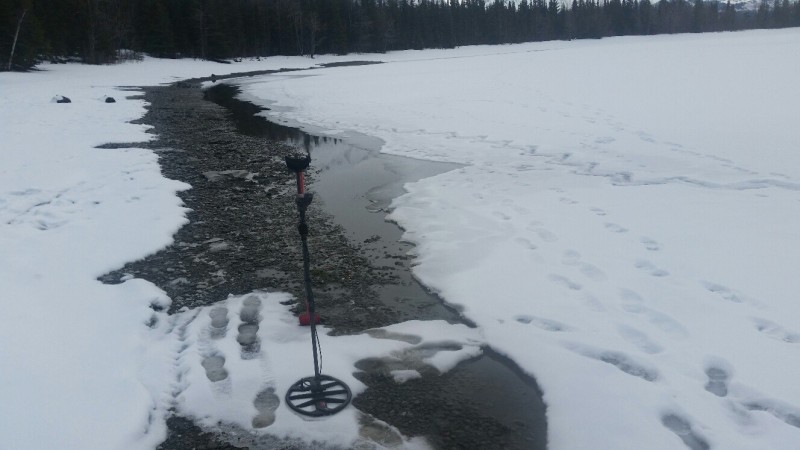
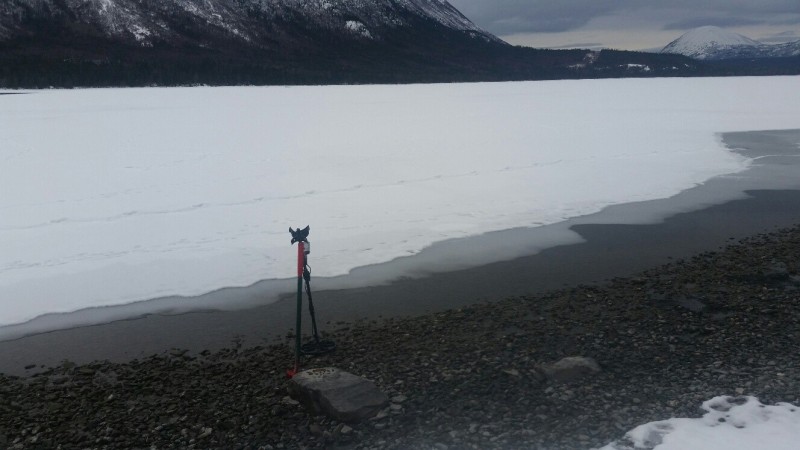
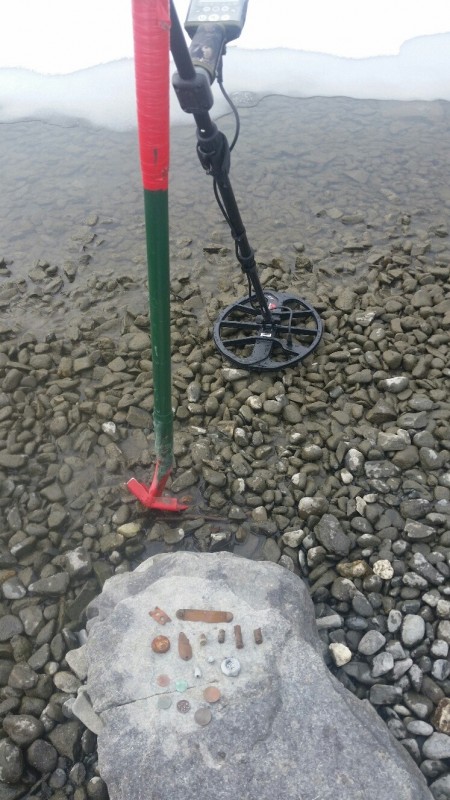
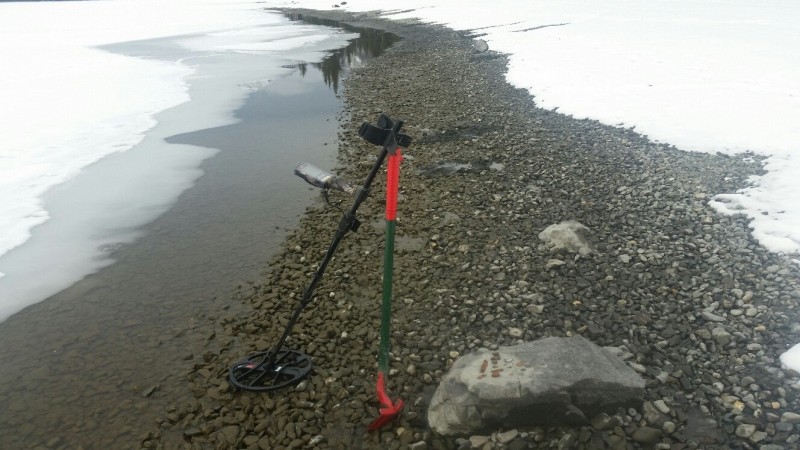
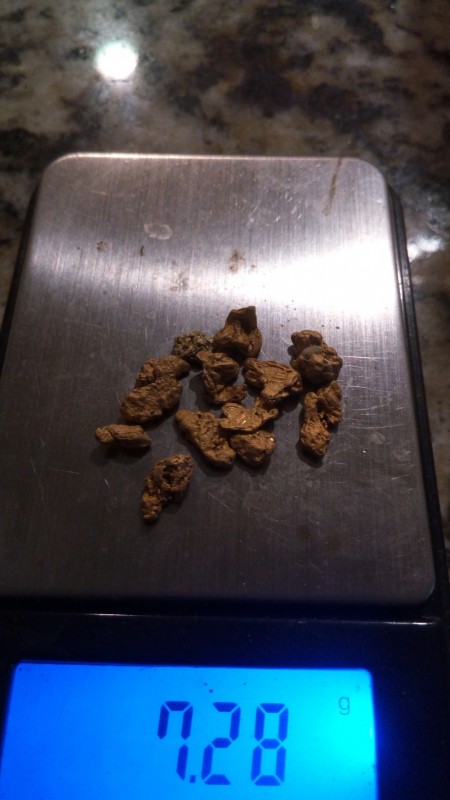

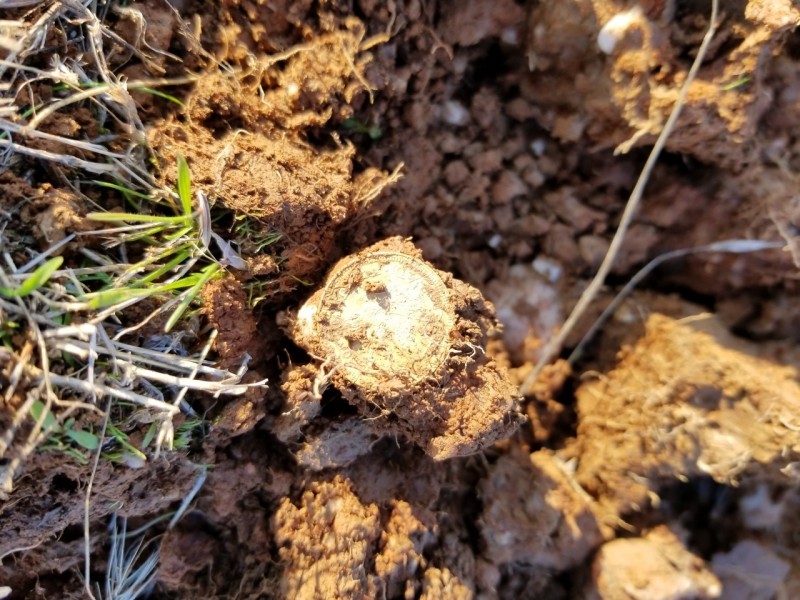
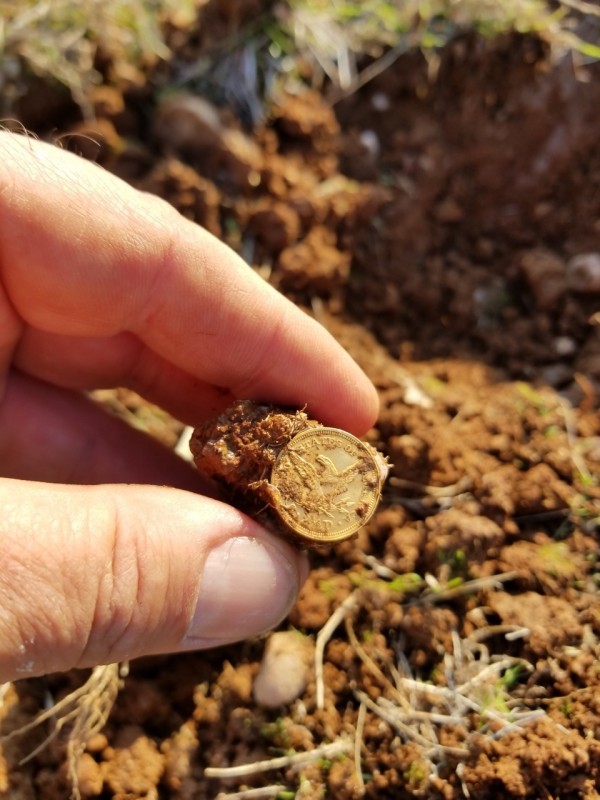
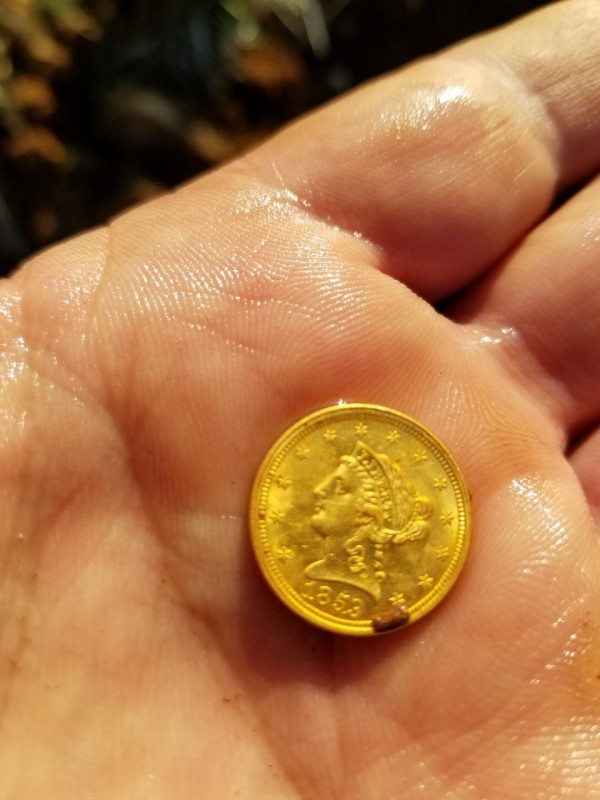
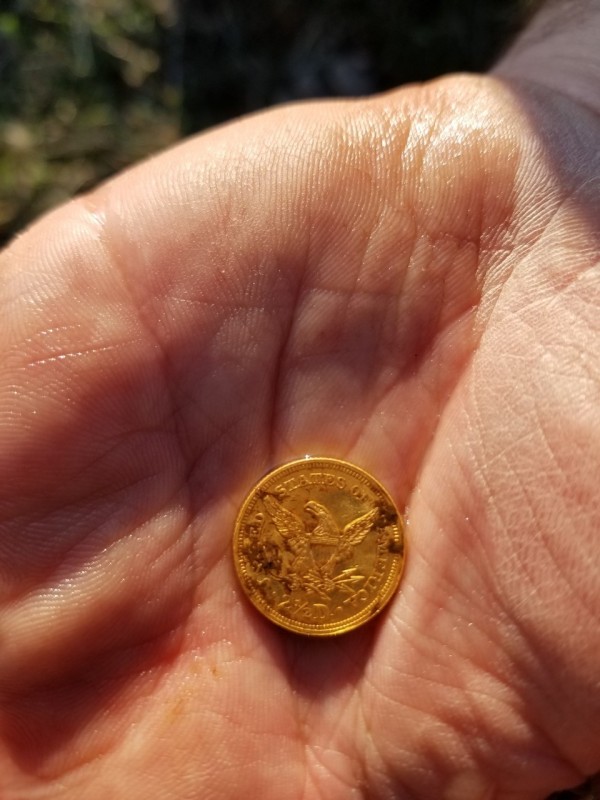
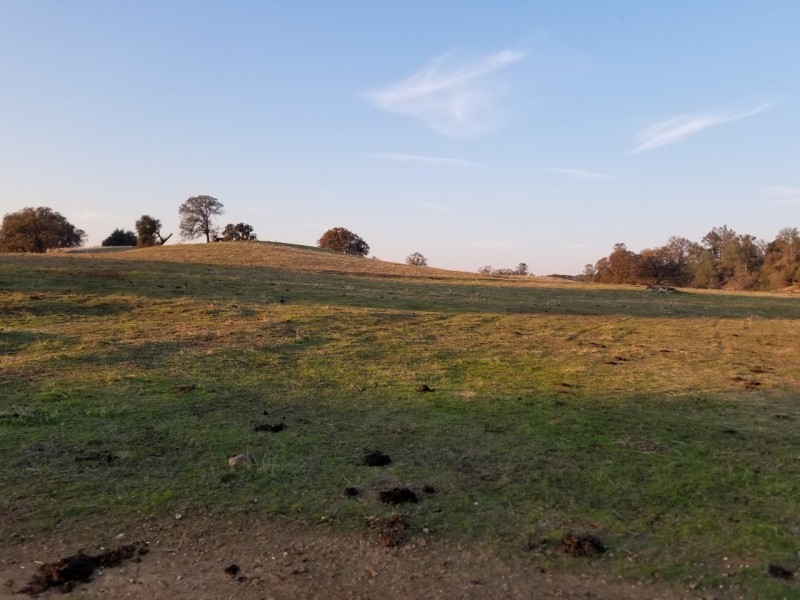
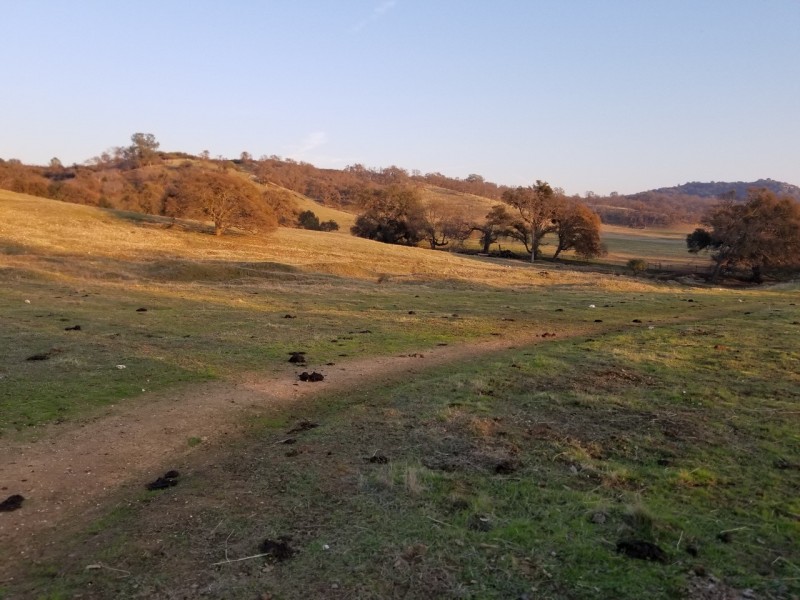



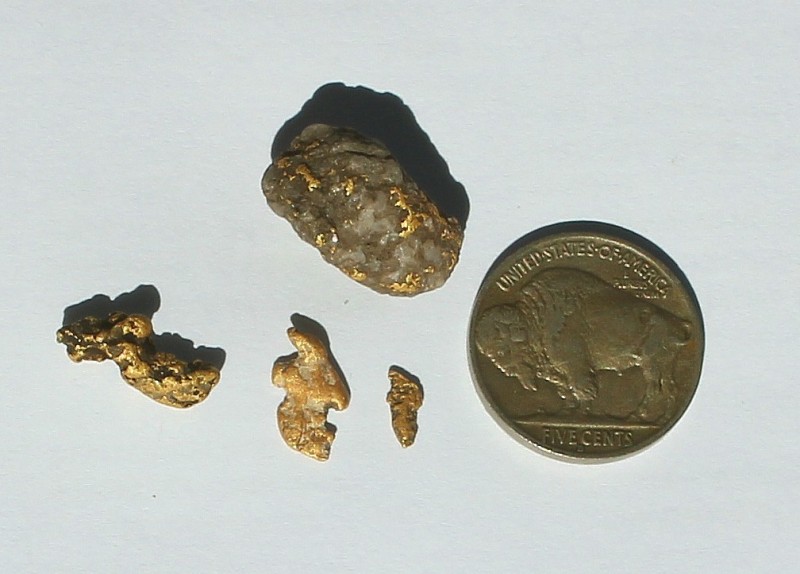
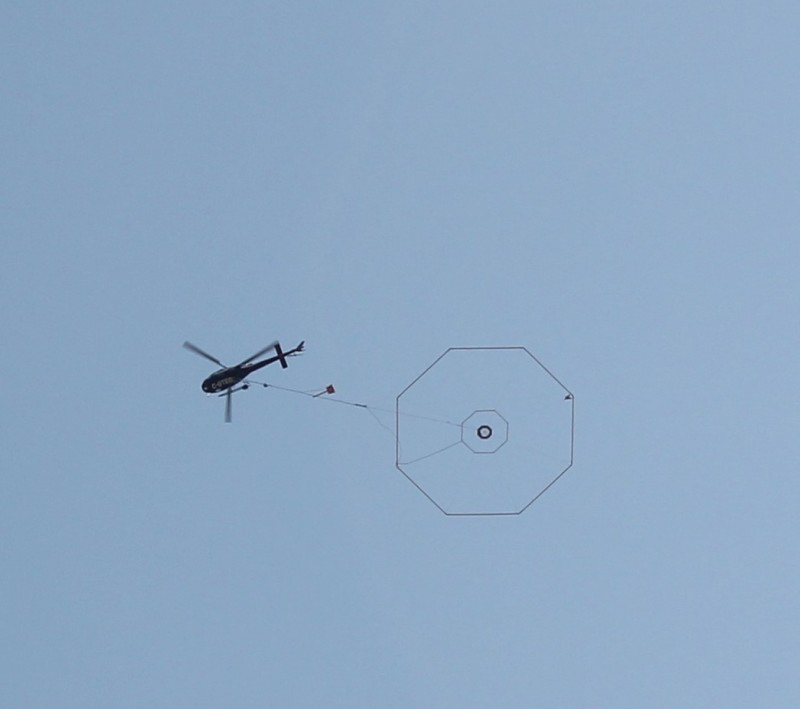
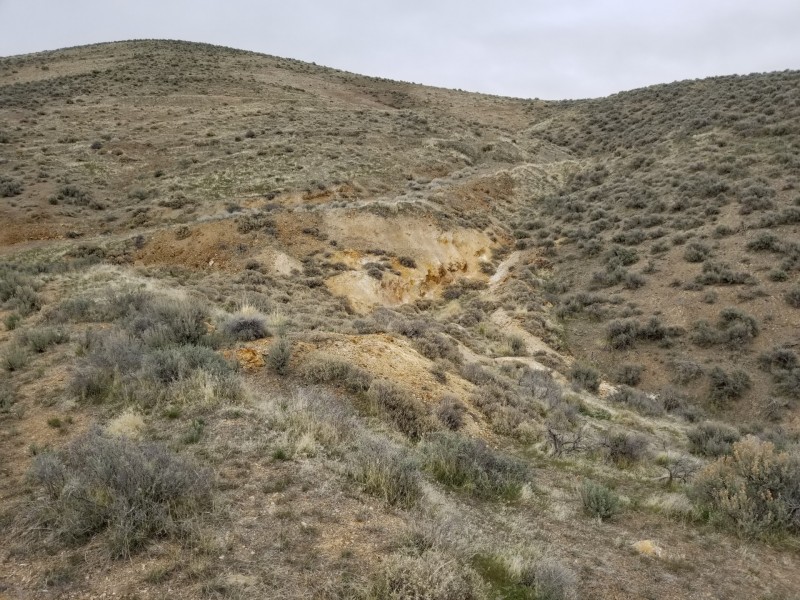
.thumb.jpg.77e4cb5bf39d44bdd2050d2edb7dfdb1.jpg)


